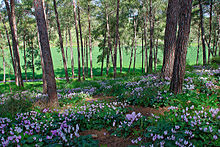Manasseh Hills

The Manasseh Hills[1] or hill country of Manasseh,[2] directly derived from Hebrew: Menashe Heights (Hebrew: רָמוֹת מְנַשֶּׁה, romanized: Ramot Menashe, lit. 'Manasseh Heights'), called Bilad ar-Ruha in Arabic, meaning "Land of Winds",[3] is a geographical region in northern Israel, located on the Carmel Range, between Mount Carmel and Mount Amir/Umm al-Fahm.
Etymology
The hill country of Manasseh or Manasseh hill country, sometimes fully capitalised,[4] is named for its location within the allotment of the biblical Tribe of Manasseh, itself named after its biblical forefather, Manasseh or Manasses.
History
During the Ottoman Period, the Menashe Hills formed part of Turabay Emirate (1517-1683), which encompassed also the Jezreel Valley, Haifa, Jenin, Beit She'an Valley, Mount Carmel, northern Jabal Nablus, and the northern part of the Sharon plain.[5][6]
During the late Ottoman period, the largest dispersal in the Mannaseh Hills was of people from Egypt, with another significant group being those from Hebron (Khalilia). These migrants likely settled in the area following the withdrawal of Ibrahim Pasha's forces and sustained themselves through vassalship in the local effendi communities or by residing in temporary or seasonal hamlets. Despite this immigration, the area was not very populated.[7]
Geography

While Manasseh hill country (Ramat Menashe) is part of the mountain range, it is just 200 m above sea level on average, and peaks at 400 m. The plateau is bordered by the Jezreel Valley to the northeast, Wadi Milh (the Yokne'am Stream[8]) to the northwest, Wadi Ara to the southeast, and the Nadiv Valley to the southwest.[3]
The Manasseh Hill Country , known in Hebrew as Ramot Menashe, was officially added to UNESCO's World Network of Biosphere Reserves in 2011. The region was credited with encompassing "a mosaic of ecological systems that represent the Mediterranean Basin's version of the global evergreen sclerophyllous forests, woodlands and scrub ecosystem types."[9]
Important Bird Area
A 2,500 ha tract of agricultural country with oak trees, on the western slopes of Mount Carmel, some 5 km from the coast, has been recognised as an Important Bird Area (IBA) by BirdLife International because it supports a population of lesser kestrels, with some 40 breeding pairs estimated in 1991.[10]
Localities
Localities in Ramot Menashe include[3]
- Dalia, a kibbutz
- Ein HaEmek, a community settlement
- Ein HaShofet, a kibbutz
- Gal'ed, a kibbutz
- Ramat HaShofet, a kibbutz
- Ramot Menashe, a kibbutz
See also
References
- ^ Gilboa, Ayelet (2014). Steiner, Margreet L.; Killebrew, Ann E. (eds.). The southern Levant (Cisjordan) during the Iron Age period. OUP Oxford. p. 624-648 [633]. ISBN 9780191662546. Retrieved 12 July 2021.
{{cite book}}:|work=ignored (help) - ^ Rasmussen, Carl G. (2014). Zondervan Atlas of the Bible. Zondervan Academic. ISBN 9780310521266. Retrieved 12 July 2021.
- ^ a b c Zev Vilnay (1980). "Ramat Menashe". Ariel Encyclopedia (in Hebrew). Vol. 8. Israel: Am Oved. p. 7585.
- ^ Zertal, Adam (2004). The Manasseh Hill Country Survey: The Shechem Syncline. The Manasseh Hill Country Survey. Vol. 1. BRILL. ISBN 9789004137561. Retrieved 12 July 2021.
- ^ al-Bakhīt, Muḥammad ʻAdnān; al-Ḥamūd, Nūfān Rajā (1989). "Daftar mufaṣṣal nāḥiyat Marj Banī ʻĀmir wa-tawābiʻihā wa-lawāḥiqihā allatī kānat fī taṣarruf al-Amīr Ṭarah Bāy sanat 945 ah". www.worldcat.org. Amman: Jordanian University. pp. 1–35. Retrieved 2023-05-15.
- ^ Marom, Roy; Tepper, Yotam; Adams, Matthew J. (2023). "Lajjun: Forgotten Provincial Capital in Ottoman Palestine". Levant. 55 (2): 218–241. doi:10.1080/00758914.2023.2202484.
- ^ Grossman, David (2004). Arab Demography and Early Jewish Settlement in Palestine: Distribution and Population Density during the Late Ottoman and Early Mandate Periods (in Hebrew). Jerusalem: The Hebrew University Magness Press, Jerusalem. p. 159. ISBN 978-965-493-184-7.
- ^ Benvenisti, Meron (2000). Sacred Landscape: The Buried History of the Holy Land since 1948. University of California Press. p. 52. ISBN 9780520928824. Retrieved 12 July 2021.
- ^ Rinat, Zafrir (4 July 2011). "UNESCO recognizes Ramot Menashe area as 'Biosphere Reserve'". Haaretz. Retrieved 5 July 2011.
Efforts to preserve nature and open spaces in Israel enjoyed yesterday international recognition, with UNESCO affording the area of Ramot Menashe the title of "Biosphere Reserve," adding it to the organization's Man and the Biosphere program.
- ^ "Ramot Menashe". BirdLife Data Zone. BirdLife International. 2021. Retrieved 23 February 2021.
